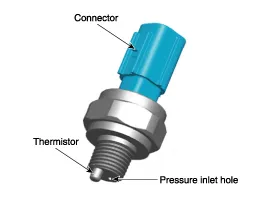Hyundai Genesis (DH): Engine Control System / Oil Pressure Sensor (OPS) Description and Operation
| Description |

Inspection 1. Turn the ignition switch OFF. 2. Disconnect the OTS connector. 3. Remove the OTS (Refer to "Removal"). 4. After immersing the thermistor of the sensor into engine coolant, measure resistance between the OTS terminals 1 and 2.
Specifications TerminalResistance (k?)2 - 42.76 ~ 4.132 - 31.89 ~ 2.843 - 41.71 ~ 2.84
Other information:
Hyundai Genesis (DH) 2013-2016 Service Manual: High Mounted Stop Lamp Repair procedures
Removal High Mounted Stop Lamp 1. Disconnect the negative (-) battery terminal. 2. Remove the roof trim assembly. (Refer to Body - "Roof Trim") 3. Remove the high mounted stop lamp assembly (A) after loosening the mounting screws. Installation 1.
Hyundai Genesis (DH) 2013-2016 Service Manual: Start/Stop Button Repair procedures
Removal 1. Disconnect the negative(-) battery terminal. 2. Remove the driver crash pad lower panel. (Refer to Body - "Crash Pad Lower Panel") 3. Remove the start/stop button (A) from the center fascia garnish after loosening the mounting clip.
Categories
- Manuals Home
- Hyundai Genesis Owners Manual
- Hyundai Genesis Service Manual
- Starter Repair procedures
- Brake System
- Engine Electrical System
- New on site
- Most important about car
